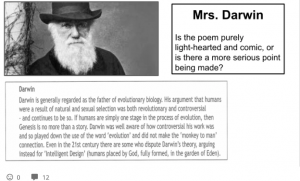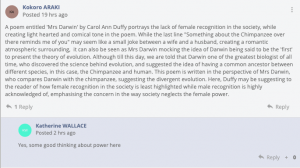Lang Lit
Practice IO – Little red cap
https://docs.google.com/document/d/1vCqFlhhXfL91DACV0Pf559TbtnEQYpdiG-I1Z5N-Yg4/edit?usp=sharing – Notes
- Timing
- I spent a lot more than a minute on introduction but I think it was necessary to give it a context
- I wasn’t very sure of how to end the oral
2. Structure and progression (into; conclusion)
- I think overall, i had a structure although i went off the path some of the times
3. Did you discuss context? Relation to the wider global issue or focus of your exploration?
- I discussed a lot of context around why she might have wrote the poem. I think I was able to discuss the real life issue around the theme of identity
4. Ideas and technical aspects: did you get a balance between discussing the two?
- I talked a lot about the use of symbolism within the poem and how it affects the reader’s understanding, conveying on what she wants to address
5. What will you ‘feedforward’ to your next practice?
- I tend to repeat the same idea over and over again so make sure i clearly know what i want to talk about
- Use more precise words to explain ideas
- Talk slower and more precisely because I tend to hurry and speak faster which may be unclear some of the times
- i was very nervous when before the oral so I think one of the things i need to work on is calming down which can be very important
Woman’s world general analysis 1
Graham Rawle
- Visual artist (Multimodal text) “Combined reading of both text and image to form a new language
Setting
- 1960s England
- Suburban setting (in between city and countryside)
- post WW2 – focus on family, a typical setting of the era
Style
- Ironic
- Wryly humorous
Background
- Mass production
- Convenience centered e.g. electricity, machinery
Idiolect of Norma
- She wants to be validated and recognised
- Norma says that her brother roy is very “caring” and “daring”. This is how Norma would have seen Roy as, if she was alive
P23 – “Roy must have ordered them in secret”
How to write an essay for advertisement
- Opening paragraph
- Thesis: Argument – overall interpretation of the advert (What is it trying to say)
- Context
- Stylistic features e.g multimodal (meaning the advert uses both text and visual representations)
2. Body paragraph
- Micro-focus – details – link to main thesis
- talk about typography
3. Conclusion
- Reiteration or echo of main thesis
- Last impression
- Link to details
Key things to focus on
- Direct address to audience: Synthetic personalisation – This is where mass audience is addressed but it feels as if an individual is addressed e.g. advert, political rally
- Hypophoric questions: A question is asked and then answered
- When writing an essay – what (idea/interpretation) + How (is that conveyed)
- Context, text type, audience, purpose, style
Advertisement analysis – Lux (soap for stocking)
| Questions | |
|
|
| 2. The text multimodal |
|
| 3. Composition and layout |
|
| 4. Describe the people and their relationship |
|
| 5. What is foregrounded |
|
| 6. Connotation of the visual image |
|
| 7. Connotation of the text/word |
|
| 8. Typography of the advert/ emphasis on certain words |
|
| 9. Mood and tone |
|
| 10. Values and assumptions reflected in the text |
|
| 11. Brand or product promoted |
|
| 12. Identity, context, audience, purpose, style |
|
Why are portrayal of disability so rare in advertising?
Overal summary
- Medal winning Paralympian and TV presenter
Sees the need to “represent and reflect society as much as possible” and “break the norm”
2. Director of Channel 4’s 2016 paralympics trailer
It was his first time doing the shots with people with disability, but he learned a lot of new things. he thinks to include these people more often.
3. head of campaign
Media should play more roles to help challenge societal stereotypes since it holds large power to influence people
Article: https://www.campaignlive.co.uk/article/invisibles-why-portrayals-disability-so-rare-advertising/1407945
Advert analysis
- The shot is focused on her facial expression rather than the disability: It is presenting her willingness and her positive attitude towards the work
- Emphasise the words “able” and “can”: focusing on what she can do rather than what she cant do
- The bolded text: declarative statement which is what the advertiser wants to tell us
- she is straight looking at the camera: suggests her confidence – disability doesnt define her as a person/ as a type writer
- The page is b/w which suggest it is old: at that time stereotypes and discrimination against disabled people were more obvious, and this is challenging the idea
Chimamanda Ngozie Adichie – Stereotype
We redid our visual map and this time we were able to use both visual and written work. It was better than how we did last time because it was in a way that if a person who hasn’t watched the video sees it, they are able to follow what the important message was. We focused on th stereotypes; what people think it is and what it actually is.
Video here: https://www.youtube.com/watch?v=D9Ihs241zeg
Dolce & Gabbana
The use of chopsticks in the advertisement is symbolic of chinese culture because it is the tool that is used everyday for the chinese people to eat, and survive. The woman who mockingly tries to use chopsticks to eat Italian food can be seen as offensive towards the chinese culture. In the advertisement, the portion of italian food is very large and the woman trying to eat it with chopsticks is acting as if she is having a hard time, in a very exaggerated manner. The Italian food is represented as if they have a higher value seeing the fact that chinese woman struggling to eat italian food, to a certain point where chinese chopsticks doesn’t serve its purpose anymore. This can also be implied that italy has higher power over China and that China cannot get as good as italy. Moreover, the stage accessories that are thought to provoke chinese culture in the advert is wrongly use, some not even one of china, this shows their seriousness towards chinese culture. Such large companies should be careful when representing another culture, since their audience is a large group of people and one wrong act can lead to damaged image of the company.
Another issue presented here is the relationship between the man and the woman in the advertisement. The man, who is not in the frame is talking to the woman in such a paternalistic manner. This suggests the gender inequality, where women in shown as if she cannot do anything without a man’s help. This is further emphasised when the man praises the woman saying “good job” in a very exaggerated and patronising manner.
Dolce & Gabbana
Write a detailed paragraph (300-350 words) which is evidence of your thinking about representation.
The use of chopsticks in the advertisement is symbolic of chinese culture because it is the tool that is used everyday for the chinese people to eat, and survive. The woman who mockingly tries to use chopsticks to eat Italian food can be seen as offensive towards the chinese culture. In the advertisement, the portion of italian food is very large and the woman trying to eat it with chopsticks is acting as if she is having a hard time, in a very exaggerated manner. The Italian food is represented as if they have a higher value seeing the fact that chinese woman struggling to eat italian food, to a certain point where chinese chopsticks doesn’t serve its purpose anymore. This can also be implied that italy has higher power over China and that China cannot get as good as italy. Moreover, the stage accessories that are thought to provoke chinese culture in the advert is wrongly use, some not even one of china, this shows their seriousness towards chinese culture. Such large companies should be careful when representing another culture, since their audience is a large group of people and one wrong act can lead to damaged image of the company.
Another issue presented here is the relationship between the man and the woman in the advertisement. The man, who is not in the frame is talking to the woman in such a paternalistic manner. This suggests the gender inequality, where women in shown as if she cannot do anything without a man’s help. This is further emphasised when the man praises the woman saying “good job” in a very exaggerated and patronising manner.





